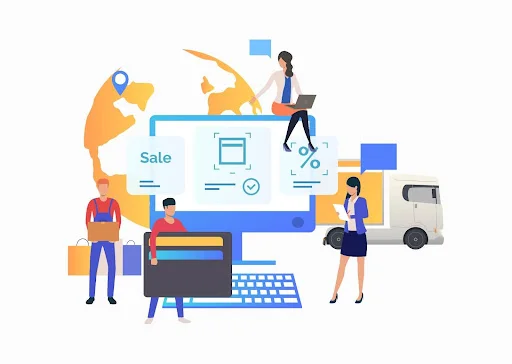When you are setting up a Shopify store the first decision you can take is whether to use a pre-built theme or hire Shopify experts for a custom theme development. It may seem to be a simple choice between budget and convenience, but it’s more labor intensive. What appears to be cost-effective today could limit your store performance in the future.
On the contrary, an exceptionally custom-coded store might cost more upfront but can save you from scalability nightmares. Before you dive your head into either direction, it’s worth to pause and consider what it is that you actually want from your Shopify store. Is it a simple temporary storefront? Are you aiming for a long-term brand with a growth objective? Do you plan to rely heavily on SEO or custom functionality?
This blog will break down the pros and cons of each option so that you can make an informed hiring decision that aligns with your business goals, timeline, and budget.
Choosing Between Custom Development and Pre-Made Templates for Your Shopify Store
Cost and Time: Short-Term Savings vs. Long-Term Investment
To use pre-made Shopify themes is the fastest and most budget-friendly option to get your store up and live. You can get quality themes from $0 to $350, with several of them offering enough customization options to make them unique. If you are working on a tight deadline or launching a small MVP, this can be the right way to go.
Hiring Shopify developers doesn’t mean paying only for aesthetics – but investing in performance, SEO, mobile optimization, and scalability. A developer is proficient in optimizing your store’s backend, improving site speed, creating a custom checkout flow, and building features that are not available in stock themes. With Shopify powering nearly 4.3% of all websites on the internet, to stand out in a crowded market often requires more than a good-looking theme.
Customization: How Far Can a Theme Take You?
Themes often tend to be plug-and-play but with limits. Most of them offer some flexibility in fonts, colors, and layout blocks. But if you are considering building unique customer journeys or integrating third-party features, you might stumble upon roadblocks.
Hiring Shopify experts gives you full control. You get to implement dynamic filters, integrate real-time shipping charges, and even sync the store with your ERP or inventory system. This flexibility is the reason why tech companies and ambitious startups often skip themes and go straight to custom builds. Something as simple as a custom product bundling feature can be difficult to achieve without touching the code. This is where experienced developers prove to be invaluable.
Expand your knowledge with this handpicked companion read.
Performance and Speed Optimization
The majority of the pre-built themes are designed to appeal to the widest audience possible. This means there are highly likely chances that they are bloated with unnecessary scripts, animations, or apps that you will never use. This can significantly slow down your website affecting your SEO and user experience.
On the contrary, when you hire expert Shopify developers they can strip away the fluff and optimize performance from the bottom level. They implement lazy loading for images, reduce render-blocking resources, and ensure that your Core Web Vitals are strong. This is something that Google increasingly uses as a ranking factor.
For a faster checkout you need to onboard a skilled developer to optimize it. For instance, if you are looking for a store that loads in under 2 seconds with high traffic, it’s the magic of custom code that makes it possible and not generic themes.
Branding and User Experience: The Make-or-Break Factor
Ask yourself how you want your customers to feel when they land on your website? If you are aiming to deliver a brand experience that feels premium, quirky, elegant, and minimalist, themes can only take you so far. They may include design presets, but true brand storytelling often needs deeper customization.
Tech companies and product-led brands choose to hire professional Shopify developers for custom development. This is because branding is not simply about color palettes – but about micro-interactions, animations, user flows, and consistent storytelling. These subtle cues help build trust and convert first-time visitors into loyal customers.
Hiring Shopify developers means creating designs that reflect your values and vision – something that no theme can perfectly replicate.
Support and Maintenance: DIY vs Professional Oversight
Themes often put a responsibility on you and your team to fix bugs, implement updates, and handle integration issues. There are forums and documentation but your revenue depends on the smooth functionality of your website, guesswork can be costly.
When you consider Shopify experts for hire you are paying for peace of mind. Developers offer ongoing maintenance, troubleshoot issues before they escalate, and ensure that integrations with payment gateways, email platforms, and analytic tools don’t break post-updates.
Tech companies especially value this because operational downtime translates into revenue loss. Ongoing developer support helps you to quickly adapt to seasonal sales, new feature rollouts, and platform updates.
When to Use a Theme and When to Go Custom
Ideal themes are those that:
- You have a tight budget and are opening a store shortly.
- You are trying a seasonal product or an idea.
- Common layouts and low functionality are acceptable to you.
Hiring developers makes sense when:
- You intend to use the brand for a long time.
- You’re looking for sophisticated features or integrations.
- Your store is a component of a wider ecosystem of products or content.
Choose Based on Growth Goals, Not Just Budget
It can be tempting to save upfront by using a theme. But if your store performance, branding, or SEO suffers as a result, the cost can be higher than you think. That’s why so many tech companies eventually pivot to hiring Shopify developers after reaching limitations with pre-built themes.
These developers can transform your store from average to exceptional, whether it’s speed, mobile usability, or backend integration. Their work sets you apart in a crowded market with valuable enhancements. Ultimately, your decision must be based not just on where your store is today, but where you wish to be in the next 6-12 months.
Want more insights like this? Head over to 2A Magazine and start exploring.







